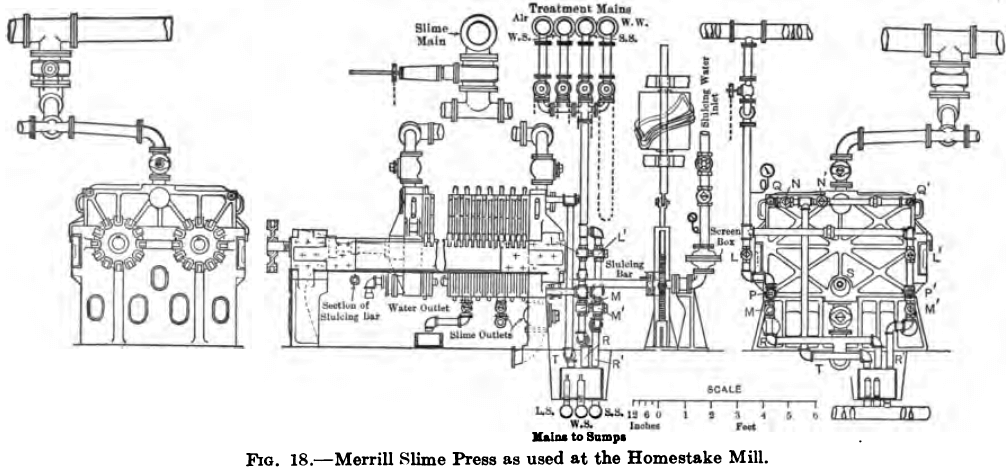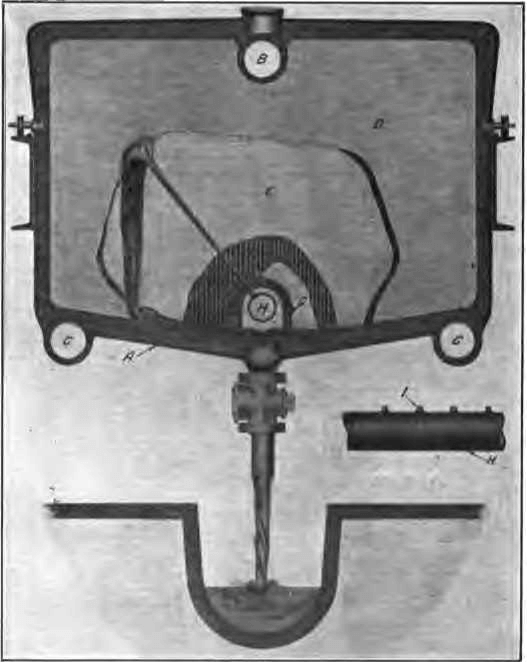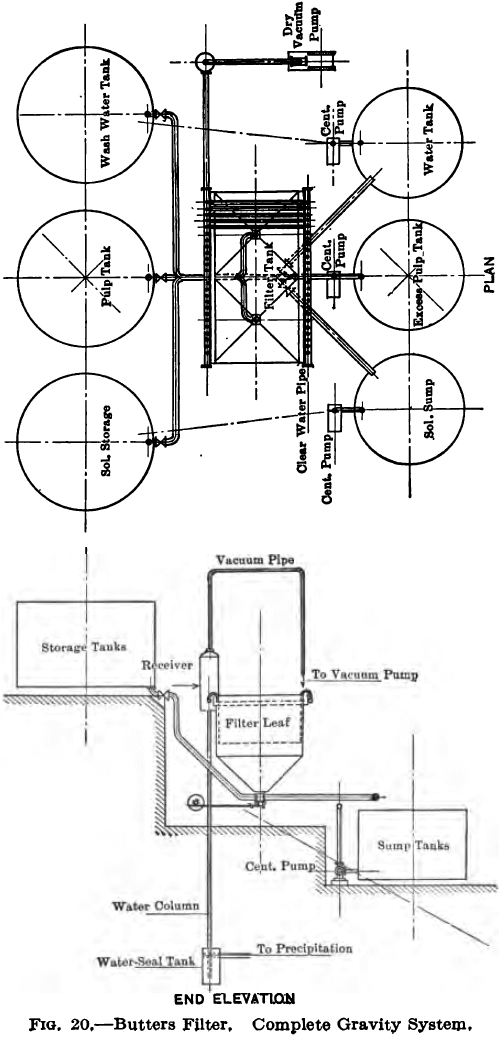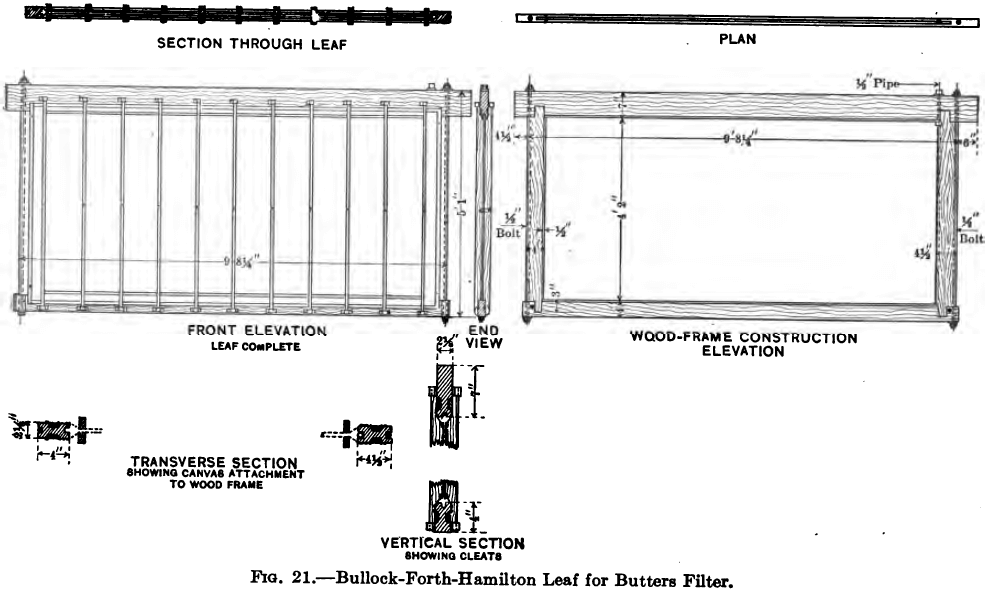The system of continuous treatment consists in allowing the stream of pulp to flow continuously through a connecting series of agitator tanks, as distinguished from the intermittent system where a charge is placed in a tank and agitated therein until the dissolution of the precious metals is complete. It may be applied to almost any form of agitator, whether the old stirring-geared kind, the Pachuca, or the Dorr.
In the case of all these the usual method is to introduce the stream to a tank through a downcast launder or pipe to a point near the bottom and allow it to make its exit on a level with the surface of the pulp.
For Pachucas an alternative system has been devised by Huntington Adams at the Natividad Mine in Oaxaca. In each case the pulp stream enters at the surface but the outflow is obtained by cutting a section out of the stream issuing from the top of the air lift by means of a receiving box fitted with an adjustable sliding lid. By opening or closing this aperture the level of the pulp in each tank is regulated. Arrangements are also made for bypassing the pulp around any individual tank to allow of emptying for cleaning or repairs. The advantage of this system over the usual one seems to lie in ensuring a complete mixture of the inflowing untreated ore with that already in the tank and preventing the possibility of more than the normal proportion of ore passing into and out of any given tank untreated. At one mill known to the writer, however, where the system was tried the proper regulation of the stream cut from each tank was found so difficult that it had to be abandoned.
The advantages claimed for the continuous system are:
- an increase in the time of agitation for any given unit of capacity;
- less labor and attention.
These apply to all methods of agitation, but there is an additional advantage in the case of Pachuca tanks in that it obviates the loss of head due to their excessive height because the pulp makes its exit from the series only a few feet lower than the point at which it enters.
The only drawback to the continuous system seems to be the inevitable short circuiting of a portion of the pulp. The amount thus passing untreated through any given tank in the series may be considerable and will be impossible to estimate when the system of passes does not ensure a complete mixture of the incoming stream with the pulp contents of the tank before it can reach the exit.
Even when such perfect mixture takes place there will still be a definite proportion going through untreated. Assuming a series of 100-ton tanks and a flow of 10 tons per hour, then approximately 1 ton out of the 10 tons flowing into the first tank will pass out immediately untreated into the second tank of the series: one-tenth of a ton per hour of this original pulp will pass directly from the second to the third tank and so on in diminishing fractions to the end of the series.
As the action is continuous, however, the above does not represent the whole of the results of short circuiting. In order to demonstrate the modus operandi of this principle L. P. Hills in the Mining and Scientific Press of Feb. 8,1913 makes the following calculations:
“Assume a series of 100-ton tanks with a flow of 10 tons per hour. Consider the efflux from the first tank for any given hour. That 10- ton portion is composed of approximately:
0.909 tons of the influx of the given hour
0.825 tons of the first preceding hour
0.751 tons of the second preceding hour
0.683 tons of the third preceding hour
0.621 tons of the fourth preceding hour
0.565 tons of the fifth preceding hour
0.513 tons of the sixth preceding hour
0.466 tons of the seventh preceding hour
0.424 tons of the eighth preceding hour
0.386 tons of the ninth preceding hour
0.351 tons of the tenth preceding hour
The remaining 3½ tons in diminished portions back to the initial in flowing 10 tons. The great bulk of the pulp receives exceedingly long treatment, the time of treatment of different portions varying between wide limits.”
Another drawback to the continuous method exists in the case of Pachuca tanks. These tanks when kept full of pulp rapidly build up a deposit of hard slime around the sides thus seriously reducing the capacity available for pulp in motion, and proportionately reducing the time of treatment and increasing the fraction of the flow which has to pass untreated to the next tank in the series. It is therefore necessary to cut out each tank every two or three weeks for cleaning, and even so the available space for agitation is never at anytime up to the maximum cubic capacity. Besides this permanent reduction in space there is the time lost in emptying and cleaning.
Loss in Extraction Due to Continuous System
At one important mill in Mexico it was shown that the continuous system with Pachuca tanks as at that time being operated was responsible for a loss in extraction of 10 to 15 grams of silver per metric ton and the tails were reduced by that amount when the charge system was substituted for the continuous. The probability is, however, that the greatest contributary cause of this difference was due to the system of passes between tanks which allowed a straight flow from one tank to the next only a little below the pulp level. This while not attended with serious results when the tonnage and rate of flow were small yet was the cause of considerable short circuiting as the mill capacity, and therefore the volume of pulp, was increased, the velocity of flow carrying some of the pulp right across the tank to the exit before it had time to sink and become mixed with the rest of the charge. When instead of running the whole series of tanks in tandem they were connected into three of four separate series and the stream of pulp split up into an equal number of parallel streams the bad effect was reduced to a minimum, and in a case of this kind assuming that each tank is cleaned out frequently the added convenience of the continuous system would probably outweigh the remaining drawbacks.
Slime Treatment by Leaching in Filter Presses
In New Zealand in the early days of slime treatment one of the first methods to be applied commercially was the use of filter presses and at first the dissolution of the gold was effected in the press as well as the subsequent washing out of the metal-bearing solution. This worked well with surface ores on which the action of the cyanide was rapid, but later it was found necessary to conduct the treatment by agitation, reserving the use of the filter for dewatering and washing only.

THE MERRILL AUTOMATIC SLUICING PRESSURE SLIME FILTER METHOD OF SLUICING
 Fig. 19.—Merrill Slime Press. Method of Sluicing.
Fig. 19.—Merrill Slime Press. Method of Sluicing.
A. Standard container or frame.
B. Feed channel through which the slime pulp enters each frame.
C. Channels from which water or solution is drawn off during process of filtration.
D. Partially sluiced slime cake.
E. Filter cloth with portion removed showing corrugations of filter plate.
F. Filter plate.
G. Horseshoe clamp for holding filter cloth against filter plate.
H. Sluicing pipe, containing water under 60 to 90 lbs. pressure admitted at either or both ends.
I. Sluicing nozzles located at center of each container or frame.
Note.—The sluicing pipe is automatically revolved forward and back through an arc of about 180 degrees, by means of the mechanism shown at the head of the press. As the cake is washed away by the action of the jet of water playing upon it the mixture of slime- residue and water flows into the channel underneath the sluicing pipe and through the outlet cocks to the waste conduit below.
At the present day probably the only mill of importance where the entire treatment of the slime is done in presses is at the Homestake.
“The Merrill press is essentially of the ordinary rectangular flush-plate and distance frame pattern with internal channels, but equipped with the automatic discharging device which is the distinguishing feature of the press. A standard press, 28 of which are now in service, containing 92 4-inch frames and 91 plates, is 46 ft. long and holds somewhat over 600 cu. ft. or 25 tons of slime; under the usual treatment schedule and with average charges, its capacity is about 70 tons per day.”
The automatic discharging device referred to consists of a nozzle in the interior of each frame capable of being rotated vertically through an arc of 200 degrees. When it is desired to discharge the residue cake water is supplied to these nozzles at a pressure of 60 lb. per square inch and simultaneously the nozzles are rotated backward and forward breaking down the cake and sluicing it into the discharge channel in the lower part of the press through which it finally finds its way to the dump.
Washing out Gold bearing Solution after the Leaching
This operation constituted the chief problem in the earliest attempts to work out a slime treatment method. As early as 1893 James Park patented a process whereby the slime was agitated in a filter bottomed tank, agitation and filtration proceeding simultaneously, the paddles being arranged in such a way that no solid cake was built up on the filter medium but a gradual and homogeneous thickening of the whole mass took place. When this thickening had proceeded to a suitable point the mass was diluted with more solution and re-thickened, the operation being repeated as often as necessary.
In South Africa it was very soon decided that a series of settlements, decantations, and re-dilutions was the only method devised up to date that would even approximately meet the local conditions, and this system has been the standard and universal practice there ever since, though recently vacuum filtration has been introduced in some mills.
While the decantation process was being worked out on the Rand the problem was being solved in Australia by the use of filter presses, the principal reason for the difference probably being the scarcity of water which would have rendered the decantation process almost prohibitive in some localities. The frame and plate type of filter press is so well known that it is unnecessary to give a detailed description of it here. The form most generally used in Australian practice is the Dehne. The advantages of the system are that the metal-bearing solution may be almost completely displaced from association with the solids in a short time and with a much smaller volume of wash liquor than is possible by decantation, and also with a minimum loss of moisture in the residue. The drawbacks consist in the comparatively high cost for labor and repairs, making it unsuitable for large tonnages of low-grade material.
To obviate the expense incidental to the use of the standard type of pressure filter, developments have taken place in three directions, the first being represented by the Merrill self-dumping frame-and-plate press already described, the second by various forms of vacuum filter whereby the pressure of the atmosphere is substituted for that of pumps or hydrostatic head, and third a combination of ideas gathered from both types whereby free filtering leaves or units are suspended in a closed receiver filled with slime pulp and mechanical pressure applied to the interior as a whole.
Group No. 2 consists of the Butters, the Moore, the rotary drum filters such as the Oliver and Portland, and the disc filter or “American Continuous Suction Filter.”
The Butters filter consists of a number of filtering units or leaves suspended vertically in a containing box with hopper bottom. The leaves are usually constructed of a frame-work of pipe suspended from a 3“ X 9″ wooden support. The filtering medium consists of a cocoa matting foundation enclosed between sheets of canvas, the edges of which are so adjusted that only solution free from solid matter can enter into the interior of the unit. The pipe composing the lower part of the frame is perforated, so that when the extension of this pipe projecting above the level of the pulp is connected with a vacuum drum, the solution from the external pulp enters the unit through the canvas and passes away through the pipe system, leaving the solid matter on the canvas surface in the form of a cake. The containing box is first filled with pulp by means of a centrifugal pump and the vacuum applied to the leaves. When a cake of sufficient thickness has been built up on the canvas surface, the vacuum is lowered to a point just sufficient to keep the cakes adherent to their supports, the surplus pulp in the containing box is pumped out and replaced with barren wash solution or water, and the vacuum again raised to its maximum. The lowering of the vacuum during the time the cake is exposed to the air is very important and its purpose is to prevent excessive drying and shrinkage of the cake with formation of cracks which reduce the displacing efficiency of the subsequent wash and also tend to cause a premature dropping of the cake. When sufficient wash liquor has been forced through the cakes to displace the pregnant solution originally contained therein, the surplus remaining in the box is pumped back whence it came and the vacuum cut off the leaves. The cake is then dropped to the bottom of the box and discharged to the dump through doors at the apex of the hoppers. The dropping of the cake may be arranged to take place automatically by gravity, or pressure (either air or water) may be applied to the interior of the leaf as may be more convenient. Where possible it is usually better to drop the cake while the leaves are submerged in water, but if necessary, the operation may be performed with the box empty.

This dropping of the cakes into an empty box, however, is not so satisfactory but can usually be accomplished by using a large volume of low pressure air suddenly admitted to the interior of the leaves. The use of water for this purpose does not answer since it at once throws off a line of cake along the bottom of the leaf and thus obtains an exit so that the water level never rises within the leaf and the upper two-thirds of the cake remains undetached. The best way to effect a discharge of the cake into an empty box is to use a specially constructed leaf having a perforated pipe along its upper edge inside the canvas and attached to the wooden header, one end being closed by a plug and the other passing out through the header at the opposite end from that of the usual vacuum pipe. For dropping the cake water is admitted through the upper pipe and compressed air through the lower or usual suction pipe, the result being that the water flowing from above moistens the canvas from top to bottom, acting as a lubricator and rendering the cake easily detachable by the compressed air acting uniformly over the whole interior of the leaf.
If the leaves are kept in good repair and thoroughly pervious to the solution, this filter gives good service not merely as a dewaterer but also as a means of removing the rich pregnant solution from the residue, so that with medium grade ores no washing by decantation is needed before filtration.
The principal drawback lies in the time and expense consumed in repeated transfers of pulp, solution, and water, into and out of the container. There is also a tendency to salt the barren-wash and water-wash storage tanks making such washes less effective for their purpose, but the latter drawback can be largely overcome by using what is known as the complete gravity system and having a separate pump and pipe line each for pulp, solution, and water wash.
At the mill of the Butters Divisadero Company owing to the excessive deposition of lime in the filter canvas and the high cost of muriatic acid for cleaning, the writer introduced a different form of leaf that met the special circumstances very satisfactorily. It consisted of a wooden frame on which the cloths were fastened by merely driving in thin wooden cleats. The centre of the leaf was formed of a sheet of cocoa matting and the filtering medium was good quality twill cotton sheeting. No stitching was used but the whole was held together by vertical strips of wood about ten inches apart and easily removable. After running about a month each leaf was removed and instead of being acid treated was entirely dismantled, an operation requiring about twenty minutes. The old filter medium was thrown away and the cocoa mat put out to dry, to be subsequently beaten to free it from deposited matter and later to be inserted in a new leaf. The leaf in hand was then refitted with new sheeting and a clean mat and clamped up again for replacement in the filter box. The cost of the new sheeting was found to be considerably less than the former cost of acid for treating the canvas and in addition to this the leaf after renovation was far more efficient than the old acid treated leaf.

There seems to be an opening for the use of such a leaf in localities where muriatic acid is expensive or difficult to transport and also in cases where the deposition of lime is excessive and accompanied, as it was at Divisadero, by substances much less soluble than lime in muriatic acid.
The Moore filter is similar in principle to the Butters but in this case the leaves are made removable and are transferred successively from the pulp box to the wash solution and from there to the water wash and finally to the dumping hopper. This is done by aggregating a number of filter frames into a unit or basket and raising, transferring, and lowering by means of an electric overhead crane.
Increasing the Dissolving Effect by a Succession of Washes
It seems to be a very widely observed fact that an increase in extraction is often obtained by settling and decanting several times during treatment and substituting fresh barren solution each time as against conducting the whole period of agitation in the same solution. This is a point the writer has never been able to verify, personally. Even in some plants where the phenomenon has been reported as proved by experiment, he has been able to obtain the same extraction without changing the solution during agitation. In the majority of instances where this fact is observed the writer is inclined to believe that if an increased cyanide strength were used for the agitation a result could be obtained similar to that shown by a succession of washes. Even if this be so, it may happen in any particular case that a succession of weak washes may turn out to be more economical than a smaller amount of stronger solution, and this is a point to be decided by the metallurgist in charge.
Calculating Gold Losses in Continuous Countercurrent Decantation
Pulp and Slurry Thickening Test and Calculations
Leach Tank Agitators
Importance of Cyanide Strength in Cyanidation
The best conditions under which to conduct the treatment can only be determined for each ore by careful experiment both in the laboratory and later in the working plant. Cyanide strength varies greatly; on the Rand the most usual strength is from 0.005% to 0.02% KCN or 0.1 lb. to 0.4 lb. per ton of solution. All-gold ores can usually be treated with much weaker solutions than silver-gold and silver ores. For the latter the writer has found that the maximum extraction can rarely be obtained with a treatment solution of less than 0.1% KCN or 2 lb. per ton of solution, while if time of treatment is unduly limited, even higher strengths are advisable. In Pachuca strengths of solution up to 0.4% KCN and over are frequently used.
Effect of Pulp Dilution on Cyanidation
On this point also wide variations occur in practice. Theoretically the thinner or the more dilute the pulp is the more rapid will be the action on the precious metals. Experiments by Julian and Smart showed that taking the rate of dissolution of gold in cyanide solution alone as 100 a pulp density of 6 of solution to 1 of slime gave a rate of only 58.6, and so on in gradually diminishing amounts till a 1:1 dilution showed only a rate of 20. They account for this by the retarding influence of viscosity on the movement of the K and CN ions. In practice, however, the increased cost of handling and precipitating large volumes of solution has to be offset against the increased extraction and an economic basis arrived at.
In any case the theory above stated does not always work out in practice, and at present the ratio of solution to ore in greatest favor lies between 1¼ and 2 to 1.
It may be noted that the pulp from an all-agitation mill, that is, a pulp with a high percentage of sandy material will call for a lower ratio of solution to ore than a slime pulp from which the granular material has been separated for leaching. A separated slime may need a ratio of 2 or 3 to 1 to give the best extraction, while a general mill pulp may give as good an extraction with less mechanical troubles if treated in a 1 to 1 pulp.
The usual practice where Pachuca tanks are in use is to make a dilution for the agitation treatment that does not require any „ subsequent thickening prior to the process in use for displacing the value-bearing solution, and such dilution is usually placed between 1 and 1.2 to 1.
Time of Agitation
This may vary from a few hours in the case of free milling gold ores to several days for silver sulphide ores, and has to be determined by experiment. As already stated the time necessary may often be shortened by increasing the strength of the solution in cyanide.
